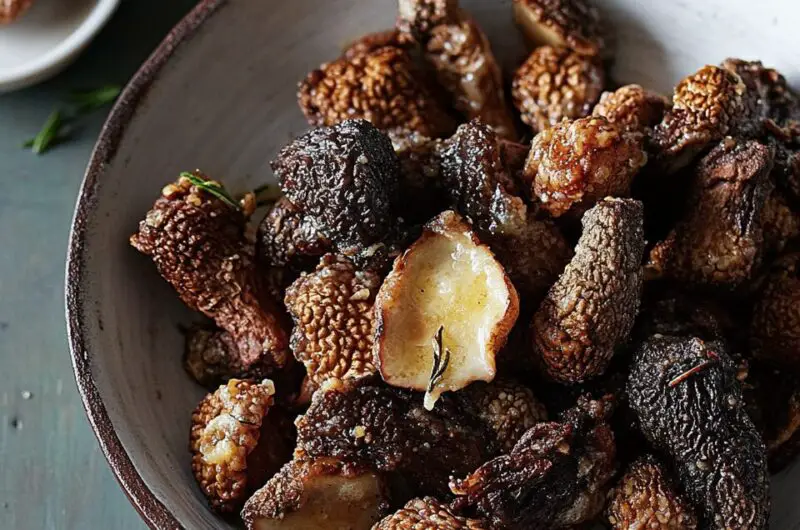Morel mushrooms are the crown jewels of wild foraged foods, and when fried in butter, their earthy flavor becomes deeply rich and nutty. Their honeycombed caps soak up just the right amount of butter, creating a crispy edge with a tender bite. This dish lets the unique character of the morel shine with minimal interference just a hint of seasoning and maybe a whisper of shallots for added elegance. Perfect for springtime or whenever you’re lucky enough to find these seasonal treasures, this recipe is a testament to the magic of simplicity. Whether served as a gourmet appetizer, a side for a protein, or the main star in a rustic vegetarian plate, morels fried in butter offer a taste of nature at its finest.
Full Recipe:
Ingredients:
-
1/2 pound fresh morel mushrooms
-
1/4 cup all-purpose flour
-
1/2 teaspoon kosher salt
-
1/4 teaspoon freshly ground black pepper
-
4 tablespoons unsalted butter
-
1 small shallot, minced (optional)
Directions:
-
Gently clean the morel mushrooms by brushing away any dirt. Slice large mushrooms in half lengthwise.
-
In a shallow bowl, mix the flour, salt, and pepper.
-
Lightly dredge the morels in the seasoned flour, shaking off the excess.
-
In a large skillet over medium heat, melt the butter.
-
Once the butter begins to foam, add the mushrooms in a single layer, working in batches if necessary.
-
Cook for about 3-4 minutes per side, or until golden brown and crisp.
-
If using, stir in the minced shallots for the final 2 minutes of cooking for extra aroma and depth.
-
Transfer to a plate lined with paper towels. Serve warm.
Prep Time: 10 minutes | Cooking Time: 10 minutes | Total Time: 20 minutes
Kcal: 180 kcal | Servings: 2 servings
Morel Mushrooms Fried in Butter: A Seasonal Delicacy Celebrated Simply
Morel mushrooms are a seasonal treasure beloved by chefs, foragers, and culinary enthusiasts around the world. Revered for their deep, earthy flavor, spongy honeycomb texture, and culinary versatility, morels represent the epitome of refined simplicity in cooking. Among the best ways to prepare them especially when you want to savor their natural taste is to fry them in butter. This preparation is not only delicious but also deeply rooted in rustic, seasonal, and traditional cuisines.
The Legacy of Morels in Culinary History
Morel mushrooms have been appreciated for centuries across different cultures. These wild fungi, belonging to the genus Morchella, appear in early spring, often around the base of dying elm trees, old apple orchards, or in recently burned forests. In France, Italy, Germany, and across the American Midwest and Pacific Northwest, morel hunting is more than a pastime it’s a cultural ritual.
French cuisine especially celebrates morels, where they are commonly paired with cream, butter, and meats like chicken or veal. Their presence in haute cuisine is a testament to their refined flavor. But even in the most gourmet kitchens, the humble act of frying morels in butter remains a favored method for showcasing their essence.
Why Simplicity Wins with Morels
The unique flavor of morels is described as nutty, meaty, and woodsy, with a slightly smoky undertone. Because of this, they require little manipulation. Over-seasoning or over-complicating their preparation can easily overwhelm their delicate flavor. That’s why frying morels in butter is often considered the gold standard it brings out their richness, deepens their aroma, and enhances their natural umami character.
Butter acts as the ideal fat for this cooking method because of its low-to-medium heat tolerance, which matches well with the cooking requirements of morels. The butter browns slightly during frying, adding a toasted note that complements the mushroom’s complexity.
Foraging and Sourcing Tips
Fresh morels are foraged in springtime, typically between March and May depending on your geographic location. Many enthusiasts enjoy heading into the woods after a rainfall, when the conditions are moist and temperatures are just right for morels to fruit.
However, if you’re not a forager or prefer a safer route many farmer’s markets, specialty grocers, and online retailers sell fresh or dried morels during the season. Dried morels, while not quite the same in texture, can be rehydrated and still provide excellent flavor. Just remember that with wild mushrooms, identification is crucial always buy from a reputable source to avoid poisonous lookalikes.
When selecting morels, look for mushrooms that are firm, dry, and have an intact structure. Avoid soggy or slimy specimens, which may indicate decay. Because they often contain bits of dirt or insects in their ridges, they must be cleaned thoroughly but gently.
Cleaning Morels the Right Way
One of the most essential steps in preparing morels is proper cleaning. Morels are famous for their ridged, hollow structure, which can trap dirt, grit, and even small bugs. Gently brushing them with a soft brush or using a damp cloth is often sufficient for lightly dirty specimens. However, if they are very dirty, a brief soak in cold, salted water can help draw out debris. But don’t soak them too long, or they may absorb too much water and lose their meaty texture.
After cleaning, let them dry completely on a towel before cooking. You want them as dry as possible when they hit the pan, so they fry instead of steam.
Cooking Technique: Why Butter?
Butter frying is ideal for morels because it complements their flavor without overpowering them. As the butter melts and begins to brown, it adds depth, sweetness, and a nutty note that pairs exquisitely with the umami of the mushrooms. The gentle sizzle of the butter ensures a crisp edge without drying the mushrooms out.
Adding a bit of finely chopped shallot or garlic in the last minute of frying elevates the aroma without masking the star ingredient. Some cooks even finish with a dash of lemon juice or a sprinkle of fresh herbs like thyme or parsley but these are optional and should be used sparingly.
The goal is not to transform the morel, but to highlight its best qualities.
What to Serve with Fried Morels
Fried morels can be enjoyed on their own as a starter, antipasto, or rustic side dish. But they also work beautifully in composed meals. Here are a few pairing suggestions:
-
Proteins: Serve them alongside grilled or roasted meats, particularly chicken, pork, duck, or steak. Their umami-rich flavor brings balance to milder proteins.
-
Eggs: Morels are delightful in brunch dishes, folded into omelets or served with soft scrambled eggs and toast.
-
Pasta or Risotto: A small portion of butter-fried morels atop creamy risotto or a simple pasta is luxurious and satisfying.
-
Toasts & Crostini: Pile them high on toasted sourdough or crusty baguette with a smear of crème fraîche or ricotta.
Wine pairings? Consider a light-bodied red like Pinot Noir or a white like Chardonnay, which complement the earthy flavor without overwhelming it.
Nutritional Value and Health Benefits
Morels are not just a culinary delight they’re also a nutritious choice. They are low in calories but packed with essential nutrients such as iron, phosphorus, copper, zinc, and vitamin D. Their high antioxidant content makes them beneficial for immune health, and they are a great plant-based source of protein and fiber.
Additionally, because they are wild-harvested and not cultivated in mass agricultural settings, they are free of pesticides or GMOs, assuming they are sourced responsibly.
Of course, like all wild mushrooms, moderation is key. It’s advised not to eat them raw, as they can cause stomach upset. Proper cooking is essential to enjoy them safely.
Common Mistakes to Avoid
Though this dish is simple, a few common mistakes can interfere with the final result:
-
Over-soaking: This leads to soggy, waterlogged mushrooms.
-
Overcrowding the pan: If the mushrooms are too close together, they’ll steam instead of fry. Always work in batches.
-
High heat: Butter burns easily. Keep your heat moderate to avoid scorched flavors.
-
Over-seasoning: Let the mushroom flavor shine just a little salt and pepper is often enough.
Sustainability and Seasonality
One of the beautiful things about cooking with morels is the connection it fosters with the seasons. They are the very definition of “eat seasonally,” appearing for just a few short weeks each year. Choosing to prepare them simply with butter and perhaps a whisper of shallot respects both the ingredient and the ecosystem it came from.
Foraging is also a sustainable way to eat when done ethically and responsibly. Foragers are encouraged to leave some mushrooms behind to allow the spores to propagate for future seasons.
Conclusion:
Fried morel mushrooms in butter is more than just a recipe it’s a seasonal ritual, a celebration of wild food, and an invitation to slow down and appreciate nature’s gifts. Whether you’ve foraged them yourself or sourced them from a local market, preparing morels with care and simplicity allows their unmatched flavor to take center stage.
This dish is perfect for anyone who values ingredients that speak for themselves. Its preparation is meditative, its taste luxurious, and its legacy steeped in culinary history. So the next time spring rolls around and you spot these wrinkly wonders, reach for a stick of butter and a skillet and enjoy a timeless, unforgettable experience on your plate.








